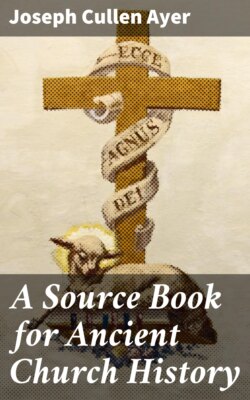Читать книгу A Source Book for Ancient Church History - Joseph Cullen Ayer - Страница 88
На сайте Литреса книга снята с продажи.
(a) Clement of Alexandria, Strom., IV, 13. (MSG, 8:1296.)
ОглавлениеThe following passages appear to be taken from the same homily of Valentinus. The pneumatics are naturally immortal, but have assumed mortality to overcome it. Death is the work of the imperfect Demiurge. The concluding portion, which is very obscure, does not fit well into the Valentinian system. Cf. Hilgenfeld, op. cit., p. 300.
Valentinian in a homily writes in these words: “Ye are originally immortal, and ye are children of eternal life, and ye desired to have death distributed to you, that ye may spend and lavish it, and that death may die in you and by you; for when ye dissolve the world, and are not yourselves dissolved, ye have dominion over creation and all corruption.”44 For he also, similarly with Basilides, supposes a class saved by nature [i.e., the pneumatics, v. infra], and that this different race has come hither to us from above for the abolition of death, and that the origin of death is the work of the Creator [pg 090] of the world. Wherefore, also, he thus expounds that Scripture, “No one shall see the face of God and live” [Ex. 33:20], as if He were the cause of death. Respecting this God, he makes those allusions, when writing, in these expressions: “As much as the image is inferior to the living face, so much is the world inferior to the living Eon. What is, then, the cause of the image? It is the majesty of the face, which exhibits the figure to the painter, to be honored by his name; for the form is not found exactly to the life, but the name supplies what is wanting in that which is formed. The invisibility of God co-operates also for the sake of the faith of that which has been fashioned.” For the Demiurge, called God and Father, he designated the image and prophet of the true God, as the Painter, and Wisdom, whose image, which is formed, is to the glory of the invisible One; since the things which proceed from a pair [syzygy] are complements [pleromata], and those which proceed from one are images. But since what is seen is no part of Him, the soul [psyche] comes from what is intermediate, and is different; and this is the inspiration of the different spirit. And generally what is breathed into the soul, which is the image of the spirit [pneuma], and in general, what is said of the Demiurge, who was made according to the image, they say was foretold by a sensible image in the book of Genesis respecting the origin of man; and the likeness they transfer to themselves, teaching that the addition of the different spirit was made, unknown to the Demiurge.
